"There is no question that climate change is happening; the only arguable point is what part humans are playing in it." -David Attenborough
It's been a long time since I've written anything on this blog about global warming, climate change, or most Earth-based environmental topics in general. After all, I'm a physicist -- an astrophysicist in particular -- and although I'm well-versed in the physics of the Earth and in science in general, it's not my particular area of expertise.
Recently, I've had a number of requests to take a look, in-depth, at the issue of global warming, and how one would go about figuring out for themselves whether the Earth was, in fact, warming, and if it were, whether human activity is playing a significant role in that?
So let's play pretend for a moment. Let's pretend the following:
- We've never heard of this problem before,
- We've never heard anyone else's opinions -- political, scientific or otherwise -- on this matter before,
- There are no other concerns such as politics, economics, energy or pollutants, and
- We actually care about the two questions of whether the Earth is getting warmer and, if it is, whether humans are the cause of it.
This is going to be a three-part post, but sometimes, getting it right takes time. So let's take the rest of this week to take that time. Here we go!
This is the Sun. To an excellent approximation, this is the source of the vast majority of energy that keeps not only Earth, but all the planets at a temperature above just a few Kelvin. (I'm going to speak about temperature in Kelvin, but I'll put the Celsius and Fahrenheit equivalent in parenthesis from now on; that would be around -270 °C / -455 °F.) During the day, we absorb energy from the Sun, but during both the day and the night, we radiate energy back into space. This is why temperatures heat up during the day and cool off during the night, something that's pretty much true for every planet that has both a day side and a night side. We also expect seasons -- cool times and warm times -- based on both how elliptical a planet's orbit is and on its axial tilt.
But if these were the only things that determined temperature, then the closest planet to the Sun would be the hottest, and they would all get progressively cooler as we moved farther and farther away. We can check this expectation by starting at the innermost planet and working our way outwards.
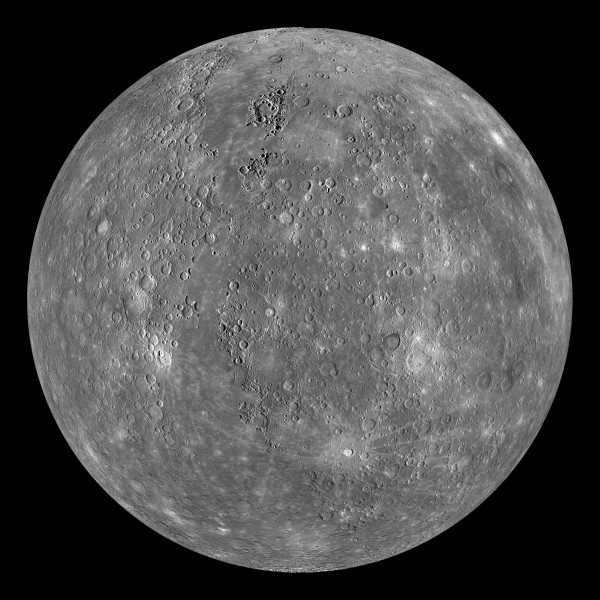 Image credit: NASA / Johns Hopkins University Applied Physics Laboratory / Carnegie Institution of Washington.
Image credit: NASA / Johns Hopkins University Applied Physics Laboratory / Carnegie Institution of Washington.
Mercury is hot. It's actually very hot! Being the closest planet to the Sun, and orbiting it in just 88 Earth-days, it achieves a maximum temperature during the day of a whopping 700 Kelvin (427 °C / 800 °F) at its hottest parts. Mercury rotates very slowly, so its night side spends quite a lot of time in the dark, shielded from the Sun; during those times, it gets down to just 100 Kelvin (−173 °C / −280 °F), which is incredibly cold, and far colder than any known naturally occurring temperatures here on Earth. So that's the story of the closest planet to the Sun, Mercury.
What about the next one out: Venus?
Venus is about twice as far from the Sun, on average, as Mercury is, and it takes about 225 Earth-days to orbit the Sun. It also rotates extremely slowly, spending more than 100 consecutive Earth-days at a time bathed in sunlight and then an equal amount of time in darkness. That's why it may come as a surprise to learn that Venus is the same temperature at all times, day or night, and that the temperature there averages 735 Kelvin (462 °C / 863 °F), making it even hotter than Mercury!
Okay, so if we want to understand what's going on with these worlds, we need to ask why?
Comparing these two worlds, there are four very stark differences:
- Mercury is much smaller than Venus,
- Mercury is about twice as close to the Sun as Venus,
- Mercury is much less reflective than Venus, and
- Mercury has no atmosphere, while Venus has a very thick atmosphere.
First off, it turns out that size doesn't matter very much. If Mercury were twice the size or Venus were half its size, neither one would have its temperature change by any appreciable amount.
The fact that Mercury is twice as close to the Sun, however, does matter.
Any object that's twice as far away from the Sun receives only one fourth the amount of solar energy per-unit-area, which means that Mercury should be receiving about four times as much energy on every part of its surface as Venus receives on its surface.
And yet, Venus is still hotter, which tells us that something important is going on with the other two points.
How reflective or absorptive any object happens to be is known as its albedo, which comes from the latin word albus, which means white. An object with an albedo of 0 is a perfect absorber, while an object with an albedo of 1 is a perfect reflector. In reality, all physical objects have an albedo between 0 and 1. You might be familiar with the Moon, which looks like it has a pretty high albedo to our eyes, appearing white in both day and at night.
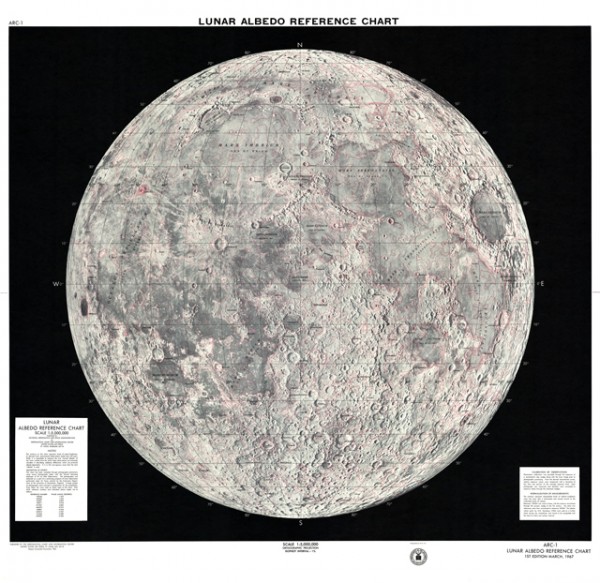 Image credit: Lunar and Planetary Institute / US Air Force, via http://www.lpi.usra.edu/.
Image credit: Lunar and Planetary Institute / US Air Force, via http://www.lpi.usra.edu/.
Don't be fooled! The Moon's average albedo is only about 0.12, which means only 12% of the light that hits it get reflected, and the other 88% gets absorbed. The lower an object's albedo is, the better it is at absorbing light, which means the higher the albedo, the less sunlight actually gets absorbed. (And I'm using Bond Albedo, for those of you who are geoscientists/planetary scientists.)
Mercury turns out to be similar to the Moon, while Venus' albedo is by far the highest of all planetary bodies in the Solar System.
So let's recap so far: even though they're different in size, that doesn't matter; Mercury receives about four times as much energy as Venus does per-unit-area; and Mercury absorbs nearly 90% of the sunlight that hits it while Venus absorbs only about 10% of the sunlight that hits it.
And yet, Venus -- even during the night -- is always hotter than anyplace on Mercury ever is.
What was that fourth point again?
4.) Mercury has no atmosphere, while Venus has a very thick atmosphere. (In fact, those of you who were very astute may have even seen it during last year's transit of Venus across the disk of the Sun!)
Ah. You see, Mercury and Venus don't just absorb light from the Sun, the planets then re-radiate that energy as heat back into space. For Mercury, all of that heat goes immediately back into space, but for Venus? It's got to get through that thick, thick atmosphere, which is difficult.
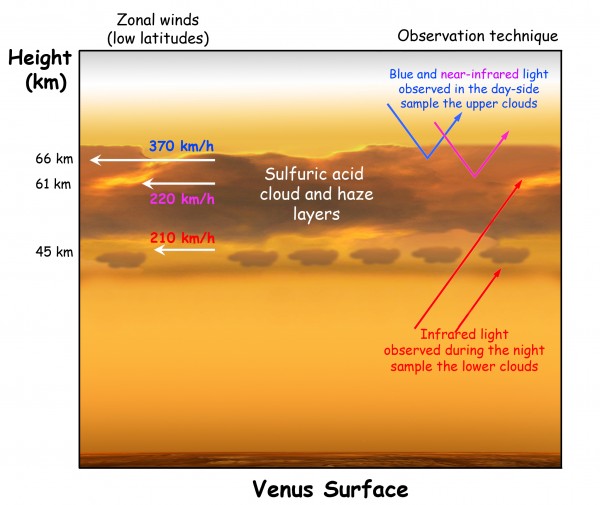 Image credit: Venus Express, via the Planetary Science Group at http://www.ajax.ehu.es/.
Image credit: Venus Express, via the Planetary Science Group at http://www.ajax.ehu.es/.
The details are such a complex thing that we'll have to save it for tomorrow, except to say that the heat that makes it through to Venus stays on Venus for a long time. It stays for long enough that it's enough to warm the entire night side to the same temperature as the day side, and it stays for long enough that it allows Venus to consistently be the hottest planet in the Solar System. If you take no other point away from this -- Part 1 of the series -- take away this: Venus' thick atmosphere is undoubtedly the reason that Venus is hotter than Mercury.
For those of you wondering where Earth fits in on those first three points:
- It's about the same size as Venus, with a diameter that's just 5% larger than our nearest planetary neighbor, although that doesn't matter for temperature.
- It's about three times as far away from the Sun as Mercury and around 50% farther away than Venus, meaning it receives about one-ninth the amount of radiation per-unit-area as Mercury does, and just less than half the amount Venus does.
- And Earth's albedo is complicated and inconsistent, due to the fact that we have a variable cloud cover (and clouds are very reflective), seasons (and green continents have a different albedo than brown ones), icecaps and snow cover which change over time, etc. Earth's albedo is about 0.30 on average, but here's a chart that illustrates how variable our albedo is as we go from location-to-location and season-to-season.
So even though the Earth's albedo is complicated, it's easy to track-and-monitor now that we've got satellites in space, and something we can easily account for when we're trying to model what's going on with our home world.
If we want to understand what the temperature of Earth is, why the temperature is what it is, and whether humans have done anything to change it over time, we've got to understand the fourth point: Earth's atmosphere. It's real, it's there, and it's important, but how important? That's what we'll take a look at.
Come back tomorrow where we'll go through the details of Venus' atmosphere and begin talking about the Earth's as well; there's a lot to discover!

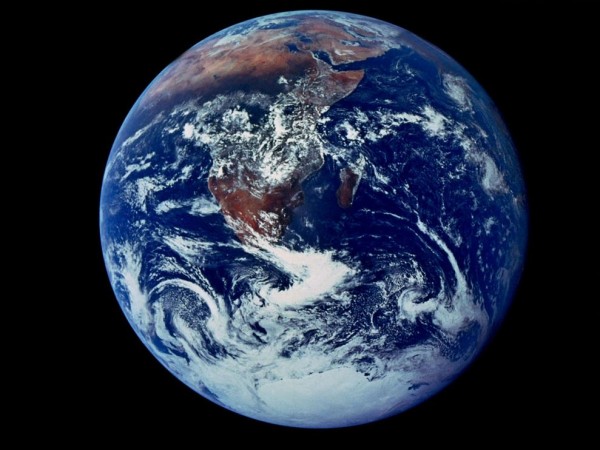

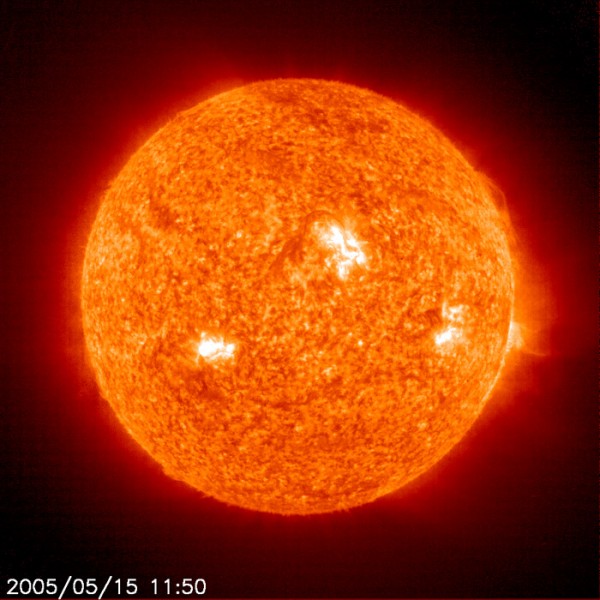

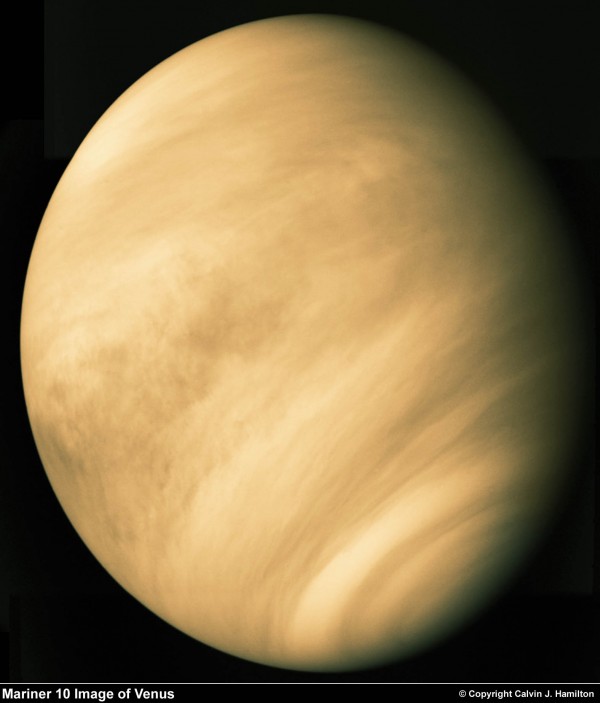
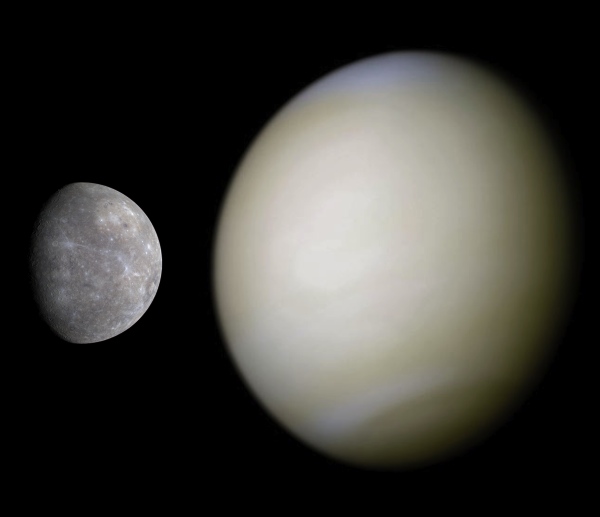
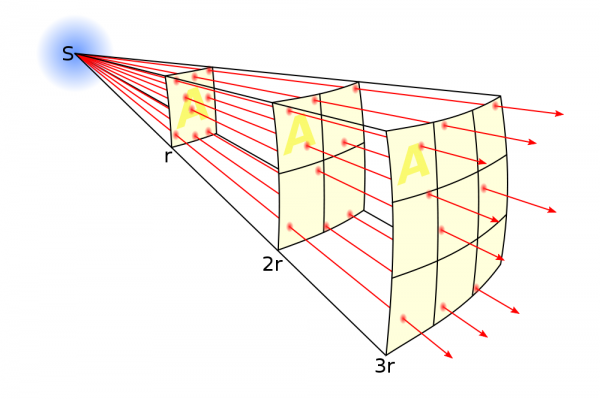

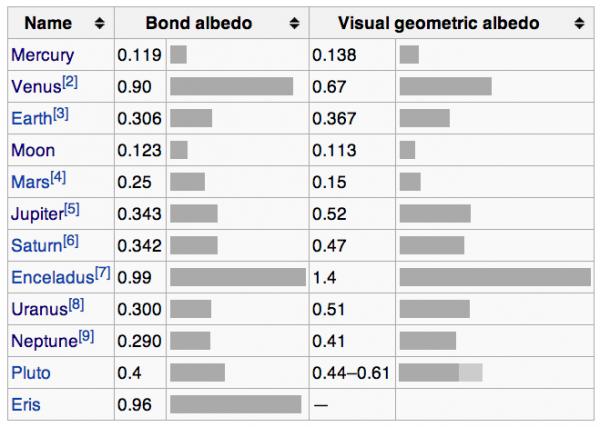

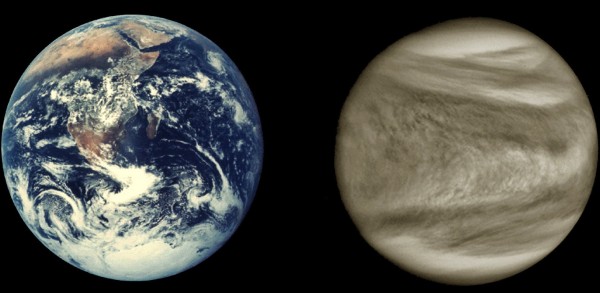

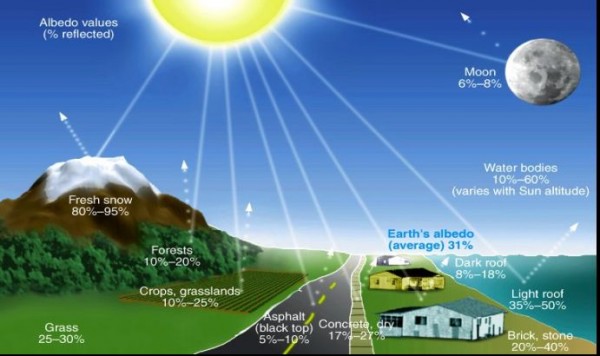
Good intro, but I've got a minor quibble. You say, "Mercury turns out to be similar to the Moon, while Venus’ albedo is by far the highest of all bodies in the Solar System." and then give a chart which show two Solar System bodies that have a higher albedo than Venus. Perhaps you meant ...highest of all the planets? Regardless, as it's worded currently, it's contradictory.
Thank you, transcendentape. I saw that Enceladus was on the chart and said to myself, "edit that text to say planets, not bodies," and then I had an image upload glitch, and promptly forgot. Thanks for the error catch; it's fixed!
As a complete astronomy novice, Enceladus I get with that awesome plume shooting out highly reflective material. But could Eris really be 0.96? The albedo figure for Eris seems highly speculative, based on a size estimate from a stellar occultation that has huge error bars, right? Is there any proposed mechanism for why it would be so high? (For the record, I am not questioning the science, just like learning about this stuff).
I really like the way you're going through this. I look forward to seeing the the rest of the series. Thanks.
@Jason #3 -- the occultation estimate for Eris's diameter has half a percent uncertainty: 2326 +/- 12 km. That doesn't seem too shabby; it translates to a geometric area uncertainty of just 1%, which should map directly to albedo (i.e., 0.96 +/- 0.01).
The suggestions I've read for why Eris's albedo is so high basically come back to a nearly pure water-ice layer (i.e., similar to Enceladus), without a lot of UV-processed organics to darken it up. This is a bit odd to me, since the published spectrum shows a good number of methane lines, so there ought to be processed hydrocarbons.
I'm really looking forward to this series! Thanks for taking the time to break it down like you do.
Thanks, Michael. I had no idea it was so precise. I vaguely remember some discussion about it's size relative to Pluto and the error seemed much larger at that time.
If we are starting out as no nothings a priori, why dismiss radius -or mass, or escape velocity? I think some sort of case ought to be made before doing that.
Omega,
The size of a planet determines both how it absorbs Sunlight -- proportional to its cross-sectional area, πr^2 -- and how it radiates heat: proportional to its total surface area, 4πr^2.
The thing is, that ratio, πr^2-to-4πr^2 (or 1-to-4), is the same for all planets, regardless of size. That is why size doesn't matter.
You'll have to trust me on the math, at least a little bit, because belaboring every detail means we'll never get anywhere, and putting in those details means I'll lose a bunch of readers who are turned off by it.
I find this link useful
http://www.skepticalscience.com/argument.php
Ethan
A worthy project even if a little simplistic.
I hope in the future climatologists pay more attention to the multitude of geological periods in the past where the CO2 concentration was much much higher than it is now(or projected i might add)and in the whole history of glaciations and uses his approach of analysis to find how and why we didn't reach the end point of Venus we see today.
While they are at it, since no one seems to be doing it, let them look at pre-historical levels of the more potent greenhouse gas of methane and its effects. Each time we've the Arctic oceans and adjoining sea bed and land warm up considerably vast amounts of methane has been released. How and Why was the earth able to avoid the Venus conclusions?
Studying the past(broad past) seems to contain more productive insights to the future possibilities than the silly projections from simplistic models we are now looking at with great alarm.
Franklin
Hi Ethan,
So far I can follow your arguments and facts, except for one detail: you say the size has no influence on the temperature. Wouldn't a bigger planet - the same density assumed - keep more of its atmosphere gravitationally and wouldn't that lead to higher temperatures? I know magnetic field also helps (Earth has one, Mars has almost none) so the solar wind can't hit and blow the atmosphere away as easy as if there was no magnetic field, but wouldn't more of the atmosphere hit by the solar wind stay anyway if the planet was heavy (=big) enough?
Lots of blah blah blah. To figure out whether the globe is warming one would take data measurements. Presuming those are good, one would then download the unadjusted and adjusted climate datasets. Then one could plot them in a spreadsheet and notice the 'hockey stick' in the so-called 'adjusted' data does not appear in the raw data. In other words the so-called 'increase' consists entirely of arbitrary 'adjustments'. Whether increase were due to natural fluctuation or man made factors would be irrelevant because there is no increase. All the blah blah blah words are not science, they are speculative mental masturbation.
The mental mastirbation is in your post gphx - and even that description is overly generous.
It took you three years to come up with that?
Oh, dear, it seems to be cut from the same, repetitive rhetorical cloth as S.N.